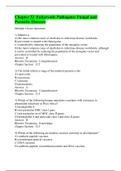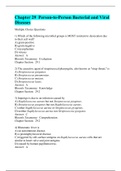Schoolcraft College
Latest uploads at Schoolcraft College. Looking for notes at Schoolcraft College? We have lots of notes, study guides and study notes available for your school.
-
21
- 0
- 0
All courses for Schoolcraft College
Latest notes & summaries Schoolcraft College
Which metric describes the proportion of EACH species present in a community? A) species abundance B) species diversity C) species evenness D) species richness 2) Which of the following represents increasing microbial diversity? A) guild-community-population B) population-guild-community C) cell-community-population D) community-guild-population 3) The abundance of cyanobacterial mats has greatly declined due to the evolution of A) antimicrobial-producing fungi. B) bacteriophages...
C-reactive protein is a A) pathogen-associated molecular pattern (PAMP). B) homotrimeric adaptor protein. C) lipoprotein. D) pattern recognition receptor (PRR). 2) Pattern recognition receptors (PRRs) are found on which of the following cells? A) macrophages B) bacteria C) neutrophils D) macrophages and neutrophils 3) Which of the following biomolecules interact with toll-like receptors (TLRs)? A) bacterial LPS B) immunoglobulins C) major histocompatibility complex proteins D)...
Malaria is A) the most common cause of death due to infectious disease worldwide. B) prevented or treated with chloroquine. C) controlled by reducing the population of the mosquito vector. D) the most common cause of death due to infectious disease worldwide, although it can be controlled by reducing the population of the mosquito vector and prevented or treated with chloroquine. 2) The initial infective stage of the malarial parasite is the A) sporozoite. B) merozoite. C) schizont. D...
) Which of the following microbial groups is MOST resistant to desiccation due to their cell wall? A) gram-positive B) gram-negative C) mycoplasmas D) viruses 2) The causative agent of streptococcal pharyngitis, also known as "strep throat," is A) Streptococcus pyogenes. B) Streptococcus pneumoniae. C) Streptococcus mutans. D) Streptococcus lactis. 3) Impetigo is due to an infection caused by A) Staphylococcus aureus but not Streptococcus pyogenes. B) Streptococcus pyogenes but...
The MOST important potential common source of infectious disease is A) industrial waste. B) arthropod reservoirs found near surface water supplies. C) water. D) human and animal wastes. 2) The degree of susceptibility a food has to microbial activity is determined by its A) chemical characteristics. B) physical characteristics. C) water content. D) chemical characteristics, physical characteristics, and water content. 3) Flour and sugar are classified as ________ foods. A) highly ...
1) A disease that is present in unusually high numbers throughout the world is called a(n) A) endemic. B) epidemic. C) sporadic. D) pandemic. 2) A ________ is a disease that primarily infects animals but can be transmitted to humans. A) nosocomial infection B) zoonosis C) vector infection D) mudurane 3) An inanimate object that transmits infectious agents between hosts is most appropriately called a A) fomite. B) carrier. C) vector. D) reservoir. 4) Which of the following ...
Two organisms that both benefit from each other are in a symbiotic relationship called A) ammensalism. B) commensalism. C) mutualism. D) parasitism. 2) The insect symbiont Wolbachia can be used to suppress disease transmission by mosquitoes because A) Wolbachia supplies essential nutrients to the mosquito Culex quinquefasciatus. B) only Wolbachia-infected mosquitoes can transmit viral diseases such as dengue fever. C) Wolbachia infections can spread rapidly through a mosquito popula...
Laboratories that work with moderate risk pathogens are classified as A) BSL-1. B) BSL-2. C) BSL-3. D) BSL-4. 2) Bacteremia is a term used A) to indicate the presence of bacteria in the blood. B) synonymously with septicemia. C) when the same organism is isolated from more than one site. D) to indicate the presence of bacteria in the lungs. 3) Which of the following must be accomplished FIRST in order to conduct RT-PCR? A) Complementary DNA must be synthesized from double-strande...
The primary function of a phagocyte is to A) destroy pathogens. B) engulf pathogens. C) evade pathogens. D) both engulf and destroy pathogens. 2) Which of the following are NOT phagocytes? A) dendritic cells B) monocytes C) neutrophils D) erythrocytes 3) Which of the following is a function of dendritic cells? A) antigen presentation B) plaque formation C) phagocytosis D) both phagocytosis and plaque formation 4) Phagocytes have a pathogen-recognition system known as _______...
Pathogenicity is the ability A) of the host to inflict damage on the pathogen. B) of the host to resist damage by the pathogen. C) of the pathogen to inflict damage on the host. D) None of these are correct. 2) Which of the following is NOT a subunit of lipopolysaccharide (LPS)? A) O-specific polysaccharide B) lipid A C) core polysaccharide D) M protein 3) One microenvironment of the skin is an area where glands produce an oily substance called A) mucus. B) sebum. C) fimbrae. D...










